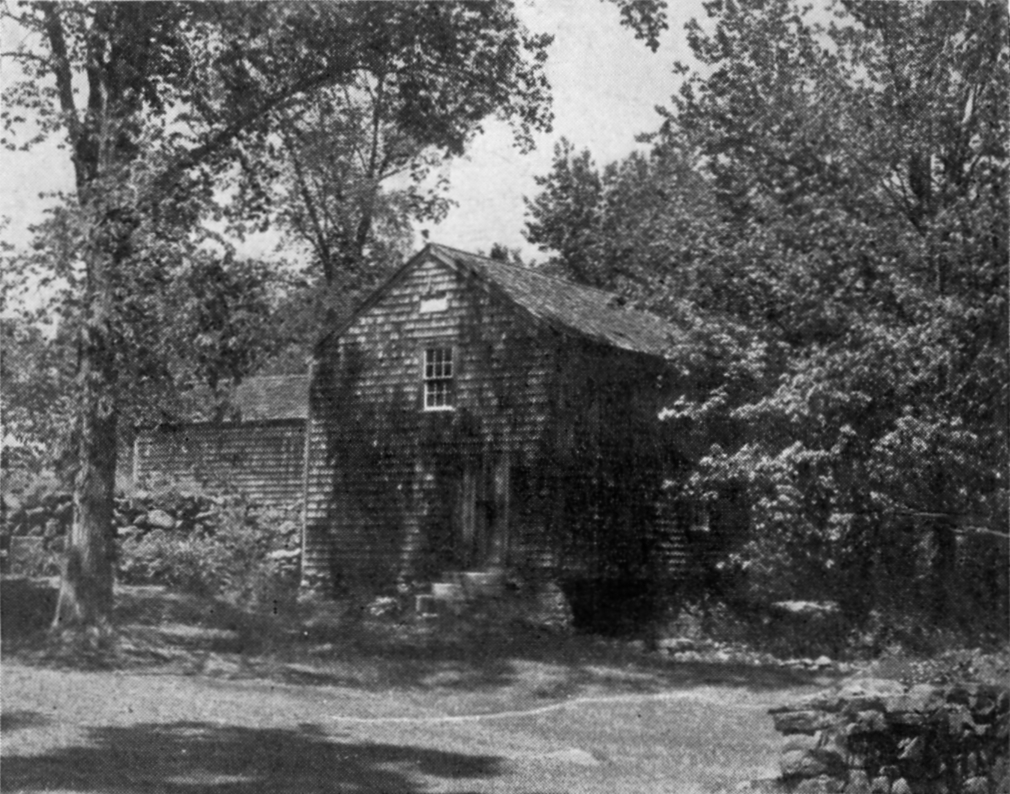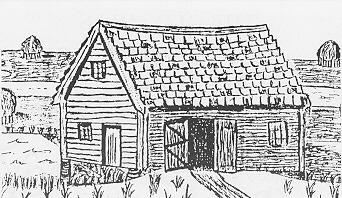Official Souvenir Program Book
January 1 – December 31, 1988
By Gerald A. (Jerry) McConnell
Still standing near the foot of High Street.
In June of this year Hampton’s historic Old Grist Mill, located near the foot of High Street will be open to the public for inspection. This mill which was in a very dilapidated condition, was repaired and put hack into safe condition a few years ago. The Old Grist Mill is one of Hampton’s few remaining links to the past, hut at one time there were over twenty mills of different types located throughout the Hampton area. In Joseph Dow’s history of old Hampton, he relates information about many of the old mills, the very first of which was probably constructed in 1640, just two years after the first settlement. It was a grist mill and it was located on what is known as ‘the landing?’ In 1642 the first windmill was erected in an area “five rods square on the hill beyond William Fuller’s lot?’ Another mill, date of origin unknown, “was built on a creek flowing into Brown’s River a few rods southerly from Eastman’s Point?’ Mr. Dow passes on the story that a farmer on his way across the marshes to this mill with a grist of corn on a handsled, passed a group of witches drinking tea off a cake of ice.
In 1658 the first sawmill was built. Prior to that time houses were made of logs and what little cutting needed was done with a whipsaw, but when frame buildings became the more acceptable form of housing sawmills became a necessity. This first sawmill was located on a spot near Taylor’s River.
In 1700 John Garland built a corn grist mill on Taylor’s River on the site where the first sawmill was built. Some time after 1841 the mill was rebuilt and named Coffin’s Mills. In 1865 Sylvanus Coffin enlarged the mill. Later he erected a large building for a box factory. In 1875 a box manufacturer from Massachusetts bought all the buildings and put in steam power. The following year in 1876 the buildings burned to the ground and were never rebuilt.
In later years Mr. Jacob T Brown and his son did build another sawmill in that general area. Also in that same area another sawmill was built by Deacon David Batchelder who passed it on to his son Moses and finally on to his grandson John Thayer Batchelder. It was located nearly a mile below Brown’s Mill.
In 1648 the town granted Abraham Perkins and Henry Green permission to build a watermill in Hampton at the Falls to become a grist mill. Another grist mill farther up the Falls River was built by Nathaniel Weare which continued in operation through the 1870’s. Still farther up the river than the Weare’s Mill, and located in the area now known as the town of Kensington, were three more mills supposed to have been built as early as 1700: a fulling mill, a pike sawmill and a grist mill. Where the Bride Hill Millstream enters Taylor River, there could be found two sawmills. In 1870 Walter Drake bought the property and operated the mills known as Drake’s Mill. Another grist mill was built in a pasture in Isaac’s Swamp on a small stream which ran into the Bride Hill Millstream.
In February 1672 the town granted permission to Peter Johnson to set up a grist mill on the little river above the meadows. He was also granted permission to set up a fulling mill and a turning gear. This is very nearly the site where a sawmill was rebuilt and operated by an R.L. Moulton and was still in operation in 1892.
In 1692 a group of men formed a company for the purpose of building and operating a sawmill on Little River above the site granted to Peter Johnson. This mill was still in existence in 1892 when Mr. Dow finished his history, but it had been sold to John F. French, son of Rev. Jonathan French, pastor of the church at “North Hill?’
On the same day that the articles of agreement regarding the foregoing mill were signed, the town granted to another company, a sawmill privilege on the same river farther down and below Peter Johnson’s.
In the area of Hampton which is now within the borders of the town of Rye, four more mills were erected. In 1695 a sawmill was built on Cedar Swamp Run near Jenness Road. A half mile above this sawmill on the same stream was Brown’s gristmill and about thirty rods below it was Jenness gristmill. The fourth mill stood about three quarters of a mile farther up the little stream than Brown’s gristmill.
In September 1686 the town granted John Tuck permission to set up a gristmill and fulling mill on the Nilus River, but the water power on the Nilus River was not sufficient to operate both mills and Mr. Tuck was allowed to make a dam farther up the river to rebuild his fulling mill, which was built a few rods west of the road leading to Little River Village. All traces of the mill had disappeared by 1867 when it was rebuilt as a shingle mill. Mr. Tuck continued to operate his grist mill on the Nilus River but continued to be plagued by poor water supply over the years and was granted permission in 1709 to dam up several springs in the general area and direct their flow into the Nilus River. By the early eighteen hundreds, Tuck’s Grist Mill had come into the possession of Reuben Lamprey who in turn sold it to Moses Leavitt. In 1815 Mr. Leavitt took down the old mill and built a new one. Subsequently Mr. Leavitt gave the mill to his son Jonathan, whose widow controlled it until her death in 1885. By 1892 the mill was discontinued.
On Brown River
In October of 1681 James Johnson and Jacob Brown were granted permission to build a gristmill on the river near the end of the highway by Jacob Brown’s pasture. Among other stipulations of the agreement was that they make gates to allow the water to run out. Thus the privilege here granted was for a tide mill. The highway mentioned is the road to the “Old Dock” along the easterly side of Benjamin Shaw’s field. Nearly a hundred years later in 1769, the tide mill burned to the ground. The mill was rebuilt after about two years. In 1855 it was built over once more and for many years thereafter it was in constant operation. In 1879 the mill was sold to the town and the mill was demolished for the supposed benefit of the marshes on which the water had been kept back.
Apparently many other smaller sawmills, windmills, grist and fulling mills were at times erected and existed for short duration. In that no precise records remain regarding those mills nothing further can be said here. So as you have seen, Hampton at one time could have been called a mill town, although the course of years over which these mills came and went were many. We are fortunate that we still have the old grist mill near the foot of High Street for current residents and future generations to see, enjoy and experience a colorful part of our past.

